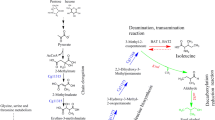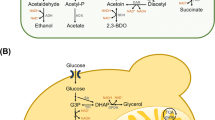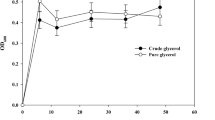Abstract
Chemical 2,3-butanediol is an important platform compound possessing diverse industrial applications. So far, it is mainly produced by using petrochemical feedstock which is associated with high cost and adverse environmental impacts. Hence, finding alternative routes (e.g., via fermentation using renewable carbon sources) to produce 2,3-butanediol are urgently needed. In this study, we report a wild-type Klebsiella sp. strain XRM21, which is capable of producing 2,3-butanediol from a wide variety of carbon sources including glucose, sucrose, xylose, and glycerol. Among them, fermentation of sucrose leads to the highest production of 2,3-butanediol. To maximize the production of 2,3-butanediol, fermentation conditions were first optimized for strain XMR21 by using response surface methodology (RSM) in batch reactors. Subsequently, a fed-batch fermentation strategy was designed based on the optimized parameters, where 91.2 g/L of 2,3-butanediol could be produced from substrate sucrose dosing in 100 g/L for three times. Moreover, random mutagenesis of stain XMR21 resulted in a highly productive mutant strain, capable of producing 119.4 and 22.5 g/L of 2,3-butanediol and ethanol under optimized fed-batch fermentation process within 65 h with a total productivity of 2.18 g/L/h, which is comparable to the reported highest 2,3-butanediol concentration produced by previous strains. This study provides a potential strategy to produce industrially important 2,3-butanediol from low-cost sucrose.






Similar content being viewed by others
References
Celińska E, Grajek W (2009) Biotechnological production of 2,3-butanediol—current state and prospects. Biotechnol Adv 27:715–725
Ji XJ, Huang H, Ouyang PK (2011) Microbial 2,3-butanediol production: a state-of-the-art review. Biotechnol Adv 29:351–364
Zeng AP, Sabra W (2011) Microbial production of diols as platform chemicals: recent progresses. Curr Opin Biotechnol 22:749–757
Syu MJ (2001) Biological production of 2,3-butanediol. Appl Microbiol Biotechnol 55:10–18
Xin F, He J (2013) Characterization of a thermostable xylanase from a newly isolated Kluyvera species and its application for biobutanol production. Bioresour Technol 135:309–315
Aiyar A (2000) The use of CLUSTAL W and CLUSTAL X for multiple sequence alignment. Methods Mol Biol 132:221–241
Tamura K, Dudley J, Nei M, Kumar S (2007) MEGA4: molecular evolutionary genetics analysis (MEGA) software version 4.0. Mol Biol Evol 24:1596–1599
Basu A, Li X, Leong S (2011) Refolding of proteins from inclusion bodies: rational design and recipes. Appl Microbiol Biotechnol 92:241–251
Basu A, Leong SSJ (2012) High productivity chromatography refolding process for hepatitis B virus X (HBx) protein guided by statistical design of experiment studies. J Chromatogr A 1223:64–71
Basu A, Mishra B, Jan Leong SS (2013) Immobilization of polybia-MPI by allyl glycidyl ether based brush chemistry to generate a novel antimicrobial surface. J Mater Chem 1:4746–4755
Rajagopalan G, Krishnan C (2008) α-Amylase production from catabolite derepressed Bacillus subtilis KCC103 utilizing sugarcane bagasse hydrolysate. Bioresour Technol 99:3044–3050
Bezerra MA, Santelli RE, Oliveira EP, Villar LS, Escaleira LA (2008) Response surface methodology (RSM) as a tool for optimization in analytical chemistry. Talanta 76:965–977
Merrill MD (1987) An expert system for instructional design. IEEE Expert Summer 25-37.
Mecozzi M (2005) Estimation of total carbohydrate amount in environmental samples by the phenol–sulphuric acid method assisted by multivariate calibration. Chemometr Intell Lab Syst 79:84–90
Jiang X, Geng A, He N, Li Q (2011) New isolate of Trichoderma viride strain for enhanced cellulolytic enzyme complex production. J Biosci Bioeng 111:121–127
Berbert-Molina MA, Sato S, Silveira MM (2001) Ammonium phosphate as a sole nutritional supplement for the fermentative production of 2,3-butanediol from sugar cane juice. Z Naturforsch 56:787–791
Petrov K, Petrova P (2009) High production of 2,3-butanediol from glycerol by Klebsiella pneumoniae G31. Appl Microbiol Biotechnol 84:659–665
Wang A, Wang Y, Jiang T, Li L, Ma C, Xu P (2010) Production of 2,3-butanediol from corncob molasses, a waste by-product in xylitol production. Appl Microbiol Biotechnol 87:965–970
Sun LH, Wang XD, Dai JY, Xiu ZL (2009) Microbial production of 2,3-butanediol from Jerusalem artichoke tubers by Klebsiella pneumoniae. Appl Microbiol Biotechnol 82:847–852
Qureshi N, Cheryan M (1989) Production of 2,3-butanediol by Klebsiella oxytoca. Appl Microbiol Biotechnol 30:440–443
Cheng KK, Liu Q, Zhang JA, Li JP, Xu JM, Wang GH (2010) Improved 2,3-butanediol production from corncob acid hydrolysate by fed-batch fermentation using Klebsiella oxytoca. Process Biochem 45:613–616
Ma C, Wang A, Qin J, Li L, Ai X, Jiang T, Tang H, Xu P (2009) Enhanced 2,3-butanediol production by Klebsiella pneumoniae SDM. Appl Microbiol Biotechnol 82:49–57
Acknowledgments
This research is supported by the National Research Foundation, Prime Minister’s Office, Singapore, under the Competitive Research Programme with a Project No. NRF-CRP5-2009-05.
Author information
Authors and Affiliations
Corresponding author
Additional information
Highlights
• A butanediol-producing bacterium Klebsiella sp. strain XMR21 was isolated.
• This strain showed diverse carbon utilization spectrum and could produce 2,3-butanediol and ethanol as its end product.
• Fermentation conditions were optimized using response surface methodology.
• Under optimized fed-batch fermentation, 91.2 g/L 2,3-butanediol could be produced.
• Strain improvement could further improve the production of 2,3-butanediol and ethanol to 119.4 and 22.5 g/L, which is comparable to the reported highest 2,3-butanediol concentration produced by previous strains.
Rights and permissions
About this article
Cite this article
Xin, F., Basu, A., Weng, M.C. et al. Production of 2,3-Butanediol from Sucrose by a Klebsiella Species. Bioenerg. Res. 9, 15–22 (2016). https://doi.org/10.1007/s12155-015-9653-7
Published:
Issue Date:
DOI: https://doi.org/10.1007/s12155-015-9653-7




